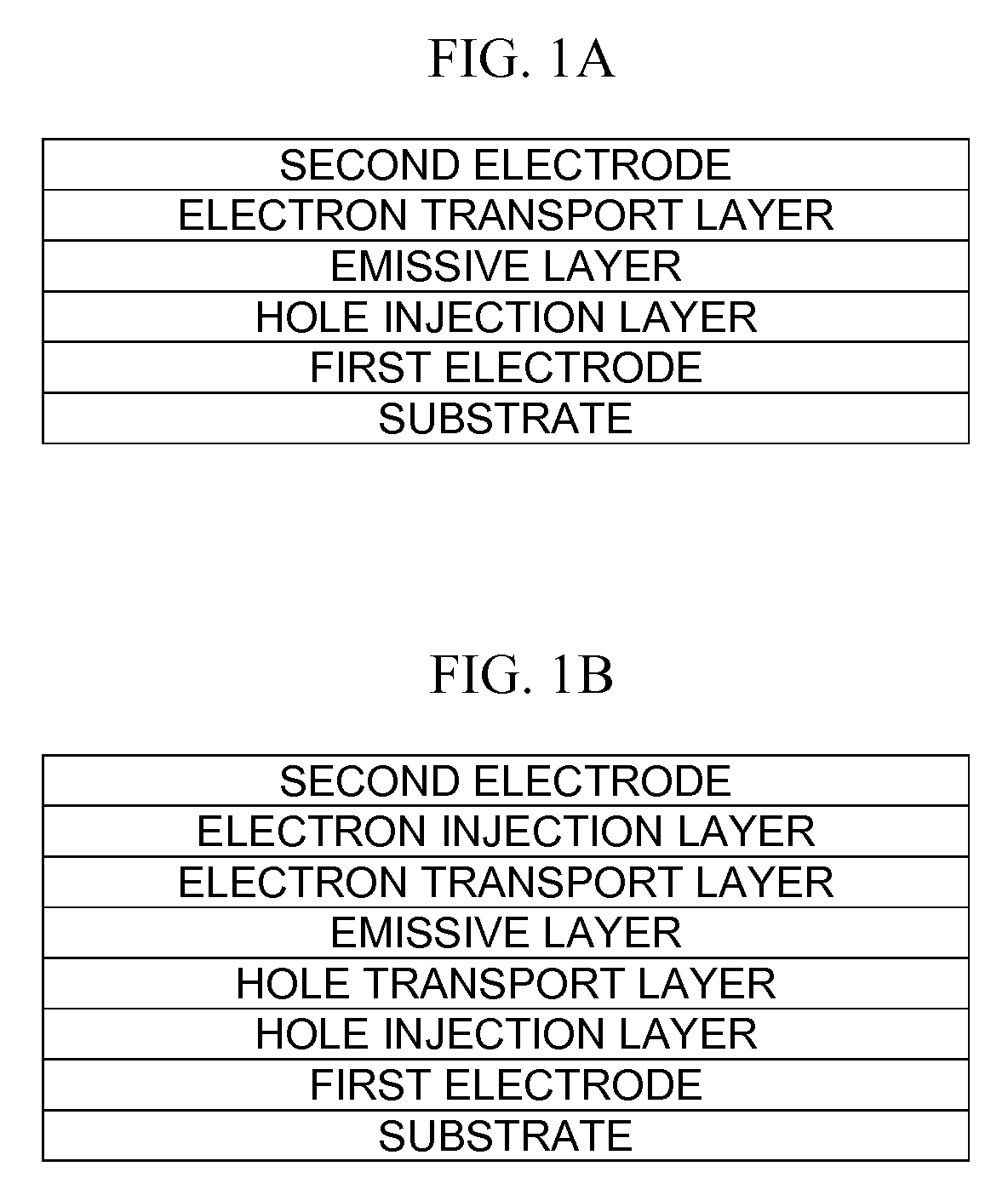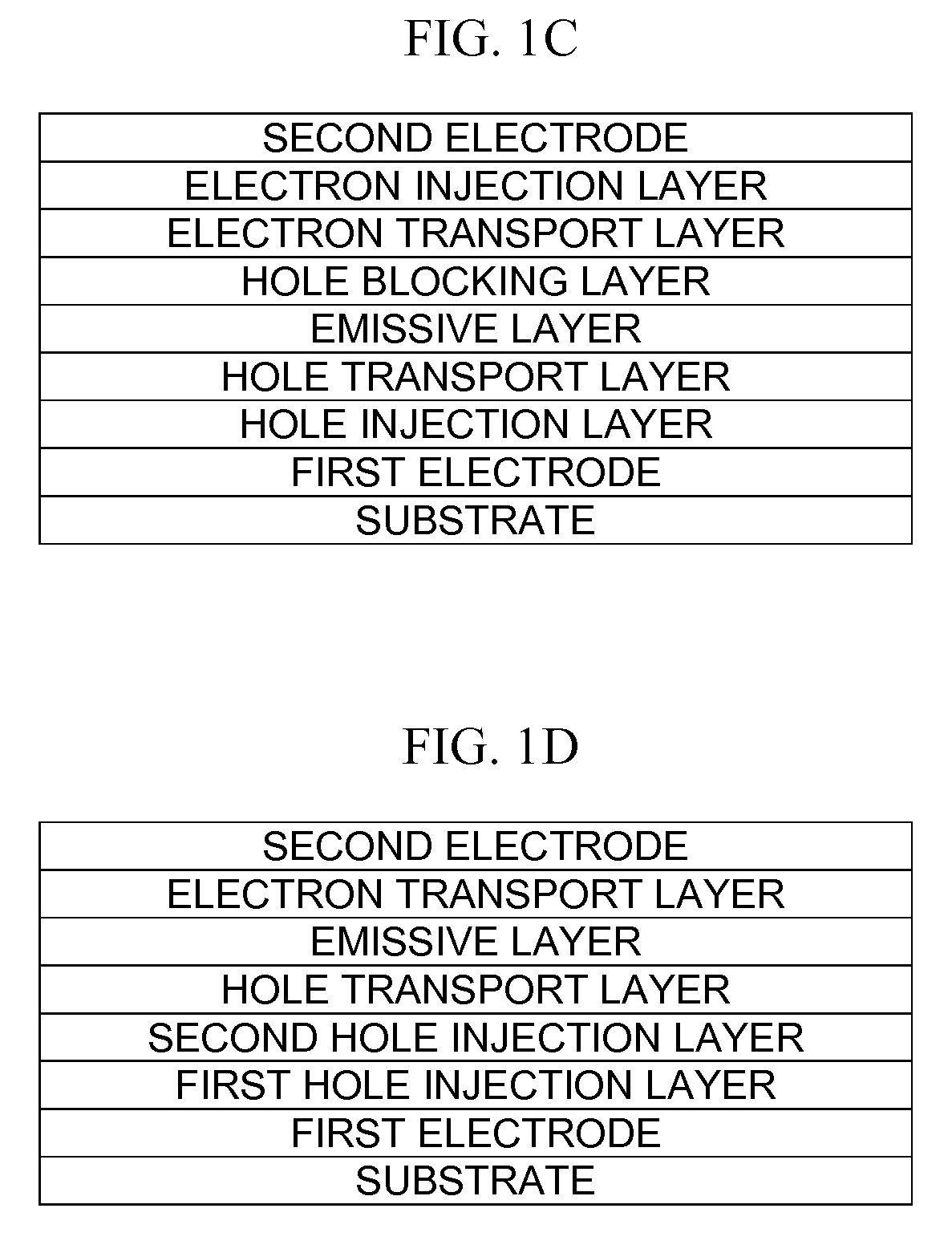Organic light emitting device
- Summary
- Abstract
- Description
- Claims
- Application Information
AI Technical Summary
Benefits of technology
Problems solved by technology
Method used
Image
Examples
example 1
Manufacture of Organic Light Emitting Device
[0074]As an anode, a Corning 15 Ω / cm2 (1200 Å) ITO glass substrate was cut to a size of 50 mm×50 mm×0.7 mm and was ultrasonically washed with isopropyl alcohol and pure water for 5 minutes, respectively. The ITO glass substrate was irradiated with ultraviolet rays for 30 minutes and washed with ozone.
[0075]Then, NPB and MoOX were co-deposited on the substrate to form a first hole injection layer with a thickness of 100 Å. Subsequently, TCTA was coated on the first hole injection layer to form a second hole injection layer.
[0076]NPB was vacuum deposited on the second hole injection layer to form a hole transport layer having a thickness of 60 nm. After the formation of the hole transport layer, 100 parts by weight of Alq3 as a host and 5 parts by weight of coumarin 6 as a dopant were vacuum deposited on the hole transport layer to form an emissive layer.
[0077]Then, 30 parts by weight of LiF and 70 parts by weight of BeBq2 were vacuum co-dep...
example 2
Manufacture of Organic Light Emitting Device
[0079]An organic light emitting device was manufactured in the same manner as in Example 1, except that 50 parts by weight of lithium quinolate and 50 parts by weight of BeBq2 were vacuum co-deposited to form the electron transport layer.
example 3
Manufacture of Organic Light Emitting Device
[0080]As an anode, a Corning 15 Ω / cm2 (1200 Å) ITO glass substrate was cut to a size of 50 mm×50 mm×0.7 mm and was ultrasonically washed with isopropyl alcohol and pure water for 5 minutes, respectively. The ITO glass substrate was irradiated with ultraviolet rays for 30 minutes and washed with ozone.
[0081]A hole injection layer formed of CuPc was formed on the substrate to a thickness of 5 nm.
[0082]NPB was vacuum deposited on the hole injection layer to form a hole transport layer having a thickness of 60 nm. After the formation of the hole transport layer, 100 parts by weight of Alq3 as a host and 5 parts by weight of coumarin 6 as a dopant were vacuum deposited on the hole transport layer to form an emissive layer.
[0083]Then, BeBq2 was vacuum deposited on the emissive layer to form a first electron transport layer (ETL1) having a thickness of 10 nm.
[0084]50 parts by weight of LiF and 50 parts by weight of BeBq2 were vacuum co-deposited ...
PUM
| Property | Measurement | Unit |
|---|---|---|
| Length | aaaaa | aaaaa |
| Percent by mass | aaaaa | aaaaa |
| Percent by mass | aaaaa | aaaaa |
Abstract
Description
Claims
Application Information
 Login to View More
Login to View More - R&D
- Intellectual Property
- Life Sciences
- Materials
- Tech Scout
- Unparalleled Data Quality
- Higher Quality Content
- 60% Fewer Hallucinations
Browse by: Latest US Patents, China's latest patents, Technical Efficacy Thesaurus, Application Domain, Technology Topic, Popular Technical Reports.
© 2025 PatSnap. All rights reserved.Legal|Privacy policy|Modern Slavery Act Transparency Statement|Sitemap|About US| Contact US: help@patsnap.com



